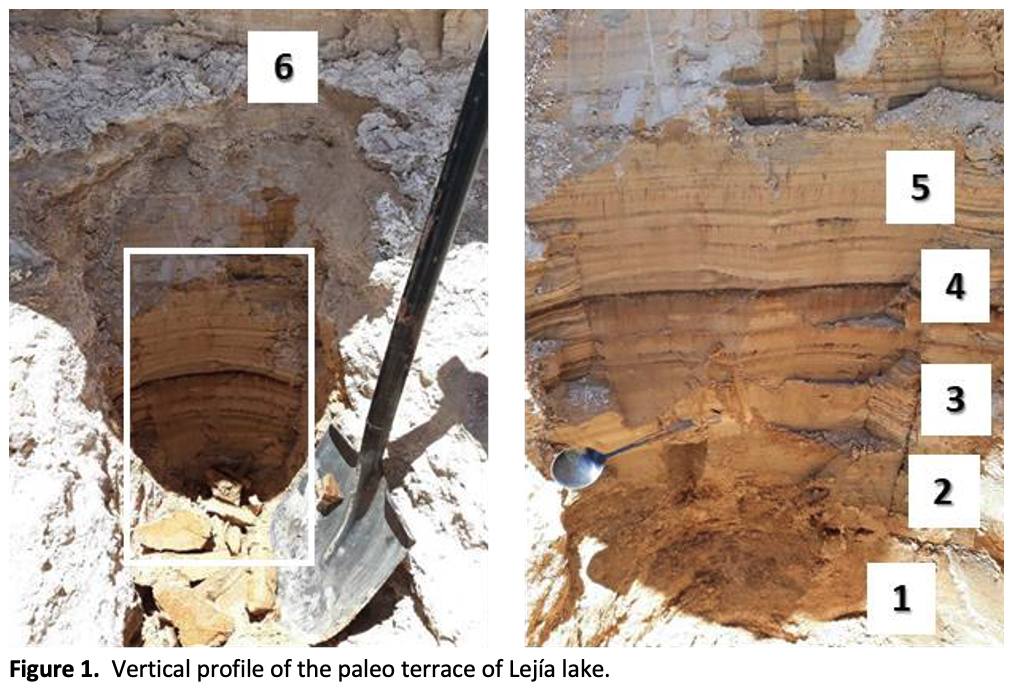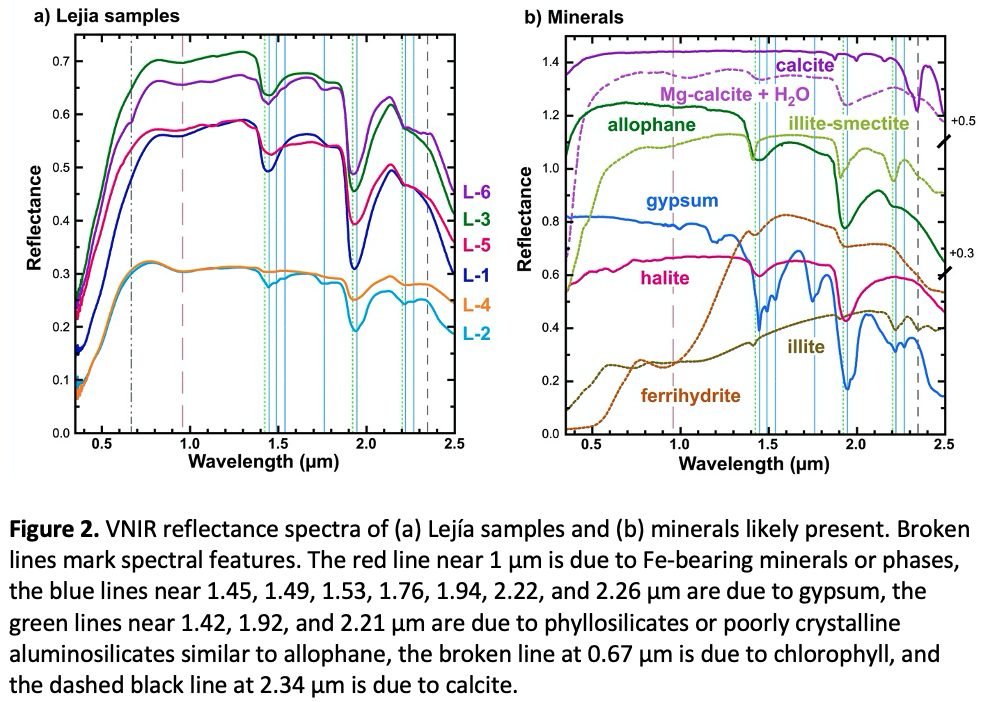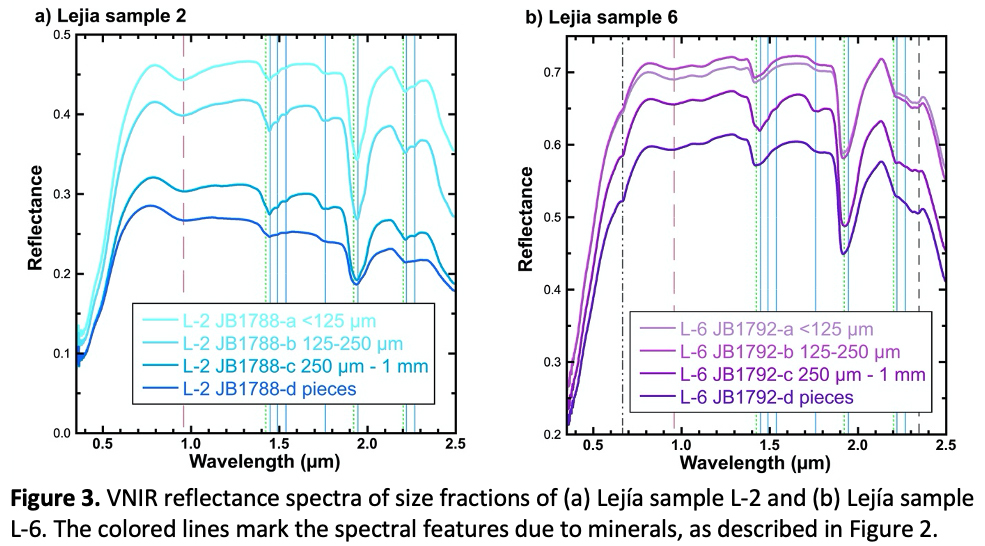VNIR Spectral Analyses of Paleolake sediments at Lejía in the Altiplano region of Chile
- 1SETI Institute & NASA-ARC, Carl Sagan Center, Mountian View, CA, United States of America (jbishop@seti.org)
- 2Centro de Astrobiología (CSIC-INTA), Dept. of Molecular Evolution, Madrid, Spain
- 3University of Montana, Department of Geosciences, Missoula, MT, United States of America
The mineralogy of paleolake sediment strata at the high elevation (~4300 m) Lejía depression in the Altiplano region of Chile reflect evolution of the lake geochemistry over time. This mineralogical study is part of a larger project characterizing the geochemistry and biology of several samples from a paleo terrace of the Lejía lake region. Visible/near-infrared (VNIR) reflectance measurements of several samples reveal variations in gypsum, carbonate, clays, iron oxides/hydroxides, and halite with depth. The spectral features are also consistent with abundant allophane or related poorly crystalline clay phases. Mg-calcite, gypsum, and poorly crystalline clays dominate the surface materials, while each of these components varies with depth at our study site. Sediments at Gale crater on Mars also include abundant poorly crystalline phases, phyllosilicates, gypsum, halite, and iron oxides/hydroxides. Thus, characterizing the spectral properties of paleolake sediments from the Lejía region may help constrain the spectral signatures of Gale crater sediments and other sites measured from orbit.
Study Site. The broader Altiplano region of Chile provides an analog for Mars due to its extremely dry and salty conditions and this study was carried out as part of the SETI Institute team’s NASA Astrobiology Institute project (Cabrol et al., 2017). The Lejía region differs from others in the Chlean Altiplano due to its higher pH environment and the presence of clay minerals and carbonates in addition to the ubiquitous gypsum and halite otherwise characteristic of the Atacama region. Laguna Lejía is a shallow, salty lake spanning ~1 km in a depression between Láscar and other volcanoes in northern Chile where a larger glacial lake (10-15 km across) once stood (Grosjean et al., 1995). This high altitude basin is battered by winds and receives only limited precipitation, mostly from melting snow and ice from the surrounding mountains. Despite limited water, high UV radiation, and cold temperatures, zooplankton communities are present at Laguna Lejía (Muñoz-Pedreros et al., 2013). Further, genome-resolved metagenomics investigations are currently being developed to characterize the communities of microorganisms and their metabolisms in the paleo sediments of the Lejía lake (Lezcano et al., in preparation).
Samples. The paleolake sediments investigated here were collected in 2018 from the upper 1 m of a lake terrace (Figure 1) adjacent to the current Lejía lake. The samples were kept frozen until studied. Extensive analyses are underway including X-ray diffraction (XRD), major element analyses, δ13C and δ15N isotope analyses, metagenomics, and lipid analyses (Lezcano et al., in preparation). XRD analyses determined the presence of albite, anorthite, Mg-calcite, gypsum, halite, andesine, muscovite, and quartz in many of these samples. Aliquots of 6 samples collected from different horizons were thawed, then air dried in the lab, gently crushed and dry sieved to <125 µm, 125-250 µm, and 250-1000 µm size fractions. For this study, we are focusing on the mineralogy and spectral properties of these samples in order to ground truth observations of similar materials on Mars via the CRISM VNIR spectrometer (Murchie et al., 2009).

Spectroscopic Analyses. Reflectance spectra of bulk sample materials and size fractions from each strata were measured using a FieldSpecPro ASD spectrometer from 0.35-2.5 µm relative to Spectralon. Spectra in this range include bands and features due to phyllosilicates, sulfates, carbonates, hydrous phases, and Fe-bearing minerals (e.g., Bishop, 2019).
Results. VNIR spectra of the Lejía samples (Figure 2) exhibit changes with depth (Figure 1). Samples L-1, L-3, L-5, and L-6 are brighter overall and have stronger bands near 1.4 and 1.9 µm due to bound or adsorbed H2O in the samples (Figure 2a). These broad bands are most consistent with poorly crystalline aluminosilicates similar to allophane or to halite (NaCl) (Figure 2b). Mg-calcite is also present in some samples and would contribute a band near 2.34 µm. Some samples also contain feldspar and quartz, which would increase the spectral brightness but do not have spectral features in this range. Samples L-2 and L-4 have darker spectra, stronger bands near 0.97 µm due to Fe-bearing phases, and weaker water bands. Sample L-2 has the strongest bands due to gypsum, which is consistent with the XRD results. Sample L-6 also has some features due to gypsum. Compositional changes with depth highlight episodic variations in inputs to the lake over time.

VNIR spectra for multiple size fractions of samples L-2 and L-6 document increases in spectral brightness typical for smaller particles as expected (Figure 3). Other small changes in the spectral properties are due to compositional variations associated with particle size. The VNIR spectra of L-2 are dominated by gypsum features at 1.45, 1.49, 1.53, 1.76, 1.94, 2.22, and 2.26 µm, but the coarse-grained samples include shifts in the bands near 1.4 and 1.9 µm towards shorter wavelengths, which is more consistent with phyllosilicates or allophane. The VNIR spectra of L-6 exhibit more variations with particle size due to the heterogeneous nature of this sample.

This VNIR spectroscopy study of paleolake samples from Lejía demonstrates detection of alteration minerals in these sediments that can be used for interpretation of the martian orbital spectra at Gale crater and related sites on Mars and subsequently for constraining the aqueous geochemical environment on Mars.
References:
Bishop, J. L. (2019) Visible and near-infrared reflectance spectroscopy of geologic materials. In: Remote Compositional Analysis: Techniques for Understanding Spectroscopy, Mineralogy, and Geochemistry of Planetary Surfaces. Cambridge University Press. 68-101.
Cabrol, N. A. and the SETI NAI Team (2017) From habitability to habitat – The current knowledge leaps and gaps in the search for biosignatures on Mars. AbSciCon, Mesa, Arizona. Abstract #3033.
Grosjean, M., Geyh, M. A., Messerli, B. & Schotterer, U. (1995) Late-glacial and early Holocene lake sediments, ground-water formation and climate in the Atacama Altiplano 22–24°S. J.Paleolimnology, 14, 241-252.
Muñoz-Pedreros, A., De los Ríos, P. & Möller, P. (2013) Zooplankton in Laguna Lejía, a high-altitude Andean shallow lake of the Puna in northern Chile. Crustaceana, 86, 1634-1643.
Murchie, S. L., et al. (2009) The Compact Reconnaissance Imaging Spectrometer for Mars investigation and data set from the Mars Reconnaissance Orbiter's primary science phase. JGR, 114, E00D07.
How to cite: Bishop, J. L., Lezcano Vega, M. Á., Parro, V., Cabrol, N. A., Sánchez-García, L., Warren Rhodes, K., and Hinman, N. W.: VNIR Spectral Analyses of Paleolake sediments at Lejía in the Altiplano region of Chile, Europlanet Science Congress 2021, online, 13–24 Sep 2021, EPSC2021-453, https://doi.org/10.5194/epsc2021-453, 2021.

